How to Grow & Care for Crassula Muscosa (Watch Chain Plant)
Written by Iris
Dec 14 2021
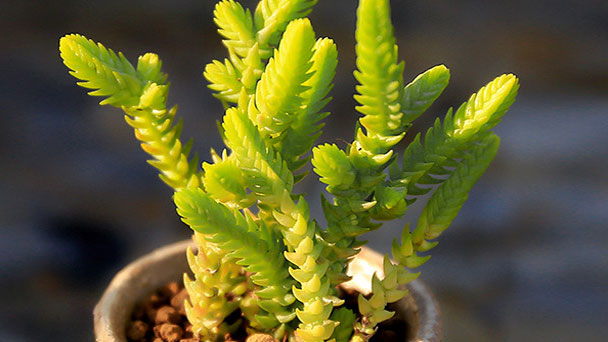
Crassula Muscosa (Watch Chain Plant) is an excellent succulent that looks great in a rock garden. The specific epithet "muscosa" is Latin for "mossy" in reference to this plant's moss-like looks. Crassula Muscosa blooms between spring and summer with tiny yellow-green flowers. Crassula Muscosa's small features make it look cute in the garden. Its delicate interlocking leaves look much like the tight jewelers' links used to attach a pocket watch to the vest, which make it the most common name Watch Chain Plant. It is also called Crassula princess pine, Zipper Plant, Lizard’s tail succulent, Clubmoss Crassula, Rattail Crassula. It is an easy-care succulent that is suitable as a houseplant. Keep reading on how to grow and care for Crassula Muscosa succulent.
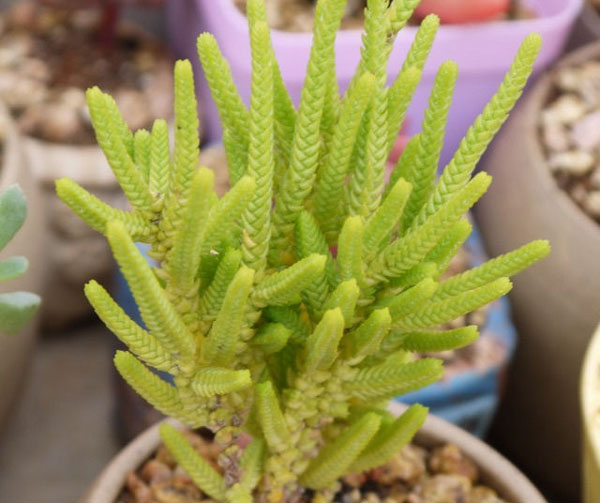
Cut down the 2 cm stem from the Crassula Muscosa plant as this is the ideal cutting size to grow a new Crassula plant.
Remove the stem from the mature plant and let it dry for a day so that the cut heals. Next, place it in a well-draining potting mix. Keep it away from direct sunlight and only water it every few days.
In about two weeks you should notice that the stem has grown its new root system. Once the root system is fully developed, you can water it once a week. As the Crassula Muscosa grows, make sure you increase the amount of light it gets every day.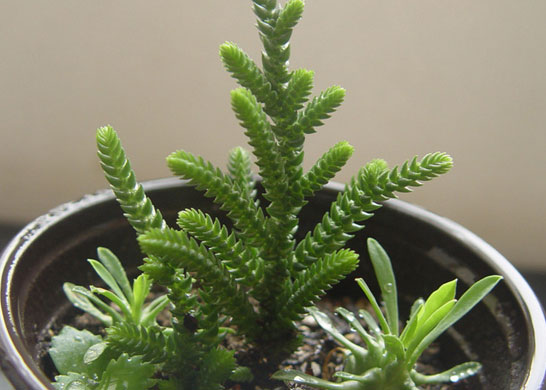
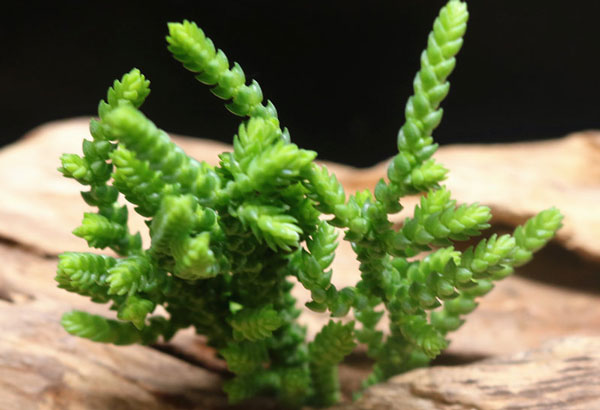
Like all succulent plants, Crassula Muscosa don't like high humidity as this can encourage fungus and rots, plenty of ventilation must always be given in very hot and wet weather, the ideal humidity for these plants is 50% or lower, but they can take much higher than this if the soil is allowed to dry out in between watering, and the soil is kept much drier in Winter.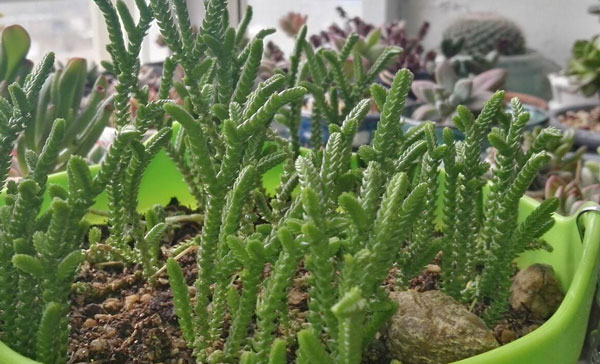
Crassula 'Morgan’s beauty': This hybrid cultivar has silver leaves dusted in white, with pretty pink late spring flowers. It grows about 4 inches tall.
Crassula erosula 'Campfire': This variety has long-branching lime leaves that turn blazing red in winter. It's a clumping plant that grows about 4 to 8 inches tall and spreads up to 2 feet wide.
Crassula pellucida variegata : This plant exhibits a flowing mass of heart-shaped leaves variegated in pink, green, and creamy yellow.
Crassula perforata: Also known as the stacked Crassula, this plant has leaves that circle around a central stem, giving it the common name string of buttons.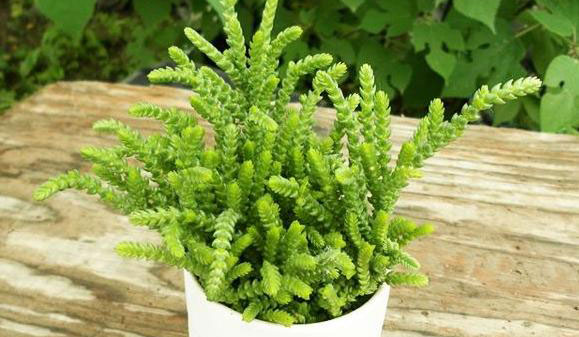
Overwatering
Crassula Muscola shares a similar trait with other succulents in that if it receives too much water, its roots could rot and the succulent could develop a fungal infection.
Overexposure to the Sun
Crassula Muscosa thrives under the brightness of the sun but overexposure to its rays will cause the succulent to dry and stiffen starting from its base all
the way to its tips. The temperature in the area where Watch Chain is growing should not exceed 60° F (15.5° C).
Infestation
Crassula Muscosa attracts mealybugs and scale insects which lead to infestation. Spray the plant with Neem Oil insecticide to keep bugs and insects away. Since these pests may come from nearby plants, it is recommended to move the succulent to another location.
| Botanical/Scientific Name | Crassula Muscosa |
| Common Name | Watch Chain Plant, Watch Chain Crassula, Crassula princess pine, Zipper Plant, Lizard’s tail succulent, Clubmoss Crassula, Rattail Crassula |
| Plant Type | String Succulent |
| Bloom Time | Between spring and summer |
| Flower Color | Tiny yellow-green flowers |
| Plant Time | During summers to springs |
| Propagation | Can be reproduced from stem cuttings or leaves or offsets |
| Light Requirements | Full to partial sun |
| Soil Requirements | Well-drained Soil |
| Watering | Allow the soil to nearly dry between the waterings |
| Suitable Temperature | 70-75 Fahrenheit / 21-24 Celsius |
| Poisonous | Toxic to cats and dogs |
Where to Grow Crassula MuscosaWhen to Grow Crassula MuscosaHow to Grow Crassula Muscosa Crassula Muscosa Propagation from Stem CuttingsCrassula Muscosa Propagation from LeavesCrassula Muscosa Propagation from OffsetsHow to Care for Crassula MuscosaCrassula Muscosa Light RequirementsSoil for Crassula MuscosaCrassula Muscosa WateringCrassula Muscosa Temperature & HumidityFertilizer Care for Crassula MuscosaCrassula Muscosa Pruning CareCrassula Muscosa Pests & DiseasesVarieties of Crassula SucculentCrassula Muscosa Care FAQIs Crassula Muscosa toxic for cats and dogs?Why is my Crassula Muscosa succulent dying?Does the Crassula Muscosa produce flowers?
Where to Grow Crassula Muscosa
Crassula Muscosa will not tolerate cold conditions, and therefore, it will be best to transfer it indoors during the cold seasons. Temperatures below 20 degrees Fahrenheit are unfavorable. The area where you will grow it in your garden should be receiving at least 6 hours of sunlight. For those who prefer indoors, then locate it close to a window that receives enough sunlight. The southern-facing window is the best if you stay in the northern hemisphere.When to Grow Crassula Muscosa
The planting season for all succulents is during summers to springs. It is a season that provides moderate warmth, sufficient water, and hours of sunlight for better growth of the crassula muscosa plant.
How to Grow Crassula Muscosa
Crassula Muscosa Propagation from Stem Cuttings
Propagating these lovely succulents is as easy as it is to care for them. Like most succulents, Crassula Muscosa plants propagate via stem cuttings. They can also be propagated from leaves, but this might be a more time-consuming process than from stem cuttings.Cut down the 2 cm stem from the Crassula Muscosa plant as this is the ideal cutting size to grow a new Crassula plant.
Remove the stem from the mature plant and let it dry for a day so that the cut heals. Next, place it in a well-draining potting mix. Keep it away from direct sunlight and only water it every few days.
In about two weeks you should notice that the stem has grown its new root system. Once the root system is fully developed, you can water it once a week. As the Crassula Muscosa grows, make sure you increase the amount of light it gets every day.
Crassula Muscosa Propagation from Leaves
When propagating Watch chain crassula with leaves, you should get a leave carefully from the mother plant. It should be a healthy leave that has no part left on the stem. In this way, the propagation will work. Before replanting, wait for a few days to allow it to callous. Use well-draining soil for your new Crassula Muscosa. Don't forget to water when the soil dries out.Crassula Muscosa Propagation from Offsets
Crassula Muscosa propagates from offsets. To be able to propagate from the mother plant, you might wait several years for the main plant to produce an offset. To start this process, use a sharp knife and remove an offset from the main plant. When you remove the offset, clean the extra soil from it. Before replanting, wait for a few days to allow it to callous. Use well-draining soil for your new succulent plant. Don't forget to water when the soil dries out.
How to Care for Crassula Muscosa
Crassula Muscosa Light Requirements
The rattail crassula does best in full or partial sun. Hot summer sun is welcome. An only bright location but directly behind a window is also suitable. This little Crassula Muscosa plant can spend the summer in the garden or on the balcony. There it has to be slowly accustomed to the sun, which is no longer filtered through a window.Soil for Crassula Muscosa
Soil and container is the essential material to grow your Crassula Muscosa. Chose a container with average size which has a drainage hole form which water could drain out. Also, use the soil which has properties to drain out water completely. Please don’t use the soil with moisture it can destroy the roots of your Crassula Muscosa.Crassula Muscosa Watering
Allow the soil to nearly dry between the waterings. Drying out for short time will be tolerated but it is better if the soil only dries to about 90 % of the pots height. Water sparingly if placed cool to temperate during winter. If the Rattail Crassula is placed in the garden during summer, the pot should not stand in a saucer or overpot so that the rainwater can run off.
Crassula Muscosa Temperature & Humidity
In Spring and Summer a good temperature is around 70-75 Fahrenheit / 21-24 Celsius, they can take higher temperatures than this as long as long as plenty of ventilation can be given, open windows if growing on windowsills indoors on very hot summer days or install a circulating fan in hot greenhouses. In Winter Crassula Muscosa can take very cold temperatures and is hardy to 20 Fahrenheit / -7 Celsius but ideally a temperature around 41 Fahrenheit / 5 Celsius is a safer minimum temperature for these plants in Winter.Like all succulent plants, Crassula Muscosa don't like high humidity as this can encourage fungus and rots, plenty of ventilation must always be given in very hot and wet weather, the ideal humidity for these plants is 50% or lower, but they can take much higher than this if the soil is allowed to dry out in between watering, and the soil is kept much drier in Winter.
Fertilizer Care for Crassula Muscosa
Typically Crassula Muscosa (Watch chain crassula) doesn’t require fertilizer in all seasons but if you want to accelerate the growth of your Crassula Muscosa plant you can use fertilizer in summers. The method of using fertilizer is very simple just you have to Mix up the fertilizer with water and release it slowly in the soil of your Crassula Muscosa plant In summers you can feed your rattail crassula monthly or weekly depending on the concentration of fertilizer with water. If the mixture of water and fertilizer is light you can use weekly otherwise if the mixture is dense you can use it monthly. Don’t overfeed your watch chain because it can affect negatively use a required dosage of fertilizer.Crassula Muscosa Pruning Care
Crassula Muscosa is best pruned every year in Spring to help prevent the stems from growing unruly and pruning this plant back also helps to prevent the stems from dropping off from the weight of the stems as they grow. Crassula Muscosa can be easily re started again as cuttings if the stems start to look too dry and brown.Crassula Muscosa Pests & Diseases
Crassula Muscosa is defensive less to mealy bugs and other large scale insects. Overwatering, poor quality and very low temperature is also the cause of root rot. Poor quality soil means the soil with more moisture and less able to drain out the water during the watering process. If accidentally your crassula lycopodioides (zipper plant) is affected, then treat it with neem oil insecticide or any other powder form insecticide. Once your Crassula Muscosa plant is affected your first task is to move affected plant to another area and remove the affected steam with a knife. After removing the affected area keep apply the neem oil for a few days until your plant will groom.
Varieties of Crassula Succulent
There are so many species and cultivars of Crassula succulent to choose from that you may become a collector. In addition to the standard jade plant cultivars (Crassula ovata), here are a few others that may catch your eye:Crassula 'Morgan’s beauty': This hybrid cultivar has silver leaves dusted in white, with pretty pink late spring flowers. It grows about 4 inches tall.
Crassula erosula 'Campfire': This variety has long-branching lime leaves that turn blazing red in winter. It's a clumping plant that grows about 4 to 8 inches tall and spreads up to 2 feet wide.
Crassula pellucida variegata : This plant exhibits a flowing mass of heart-shaped leaves variegated in pink, green, and creamy yellow.
Crassula perforata: Also known as the stacked Crassula, this plant has leaves that circle around a central stem, giving it the common name string of buttons.

Crassula Muscosa Care FAQ
Is Crassula Muscosa toxic for cats and dogs?
The Crassulaceae family is included in the American Society for the Prevention of Cruelty to Animals (ASPCA) list of plants that are toxic to cats and dogs. Although it is the Chinese Jade succulent that is identified and not Crassula Muscosa specifically, it is best not to take chances and keep the plant away from your pets.Why is my Crassula Muscosa succulent dying?
The Crassula Muscosa succulent might be dying due to the following reasons:Overwatering
Crassula Muscola shares a similar trait with other succulents in that if it receives too much water, its roots could rot and the succulent could develop a fungal infection.
Overexposure to the Sun
Crassula Muscosa thrives under the brightness of the sun but overexposure to its rays will cause the succulent to dry and stiffen starting from its base all
the way to its tips. The temperature in the area where Watch Chain is growing should not exceed 60° F (15.5° C).
Infestation
Crassula Muscosa attracts mealybugs and scale insects which lead to infestation. Spray the plant with Neem Oil insecticide to keep bugs and insects away. Since these pests may come from nearby plants, it is recommended to move the succulent to another location.
Does the Crassula Muscosa produce flowers?
Crassula Muscosa produces small, yellow-green flowers that emanate a musty-scent during the spring and mid-summer seasons. Sometimes the succulent plant's flowers bloom during the rainy months. Treat Watch Chain with frequent watering and exposure to sunlight in the summer months and you will be rewarded with a bounty of bright yellow flowers.Latest Updated
- Benefits of Bugleweed - 7 Science-backed Health Benefits
- Bugleweed Dangers & Side Effects - Is It Poisonous?
- How to Plant Evergreen Trees - What You Should Know
- When to Plant Evergreens - Grow Guide for Evergreen Trees
- 12 Wonderful Evergreen Shrubs for Your Garden
- 12 Popular Evergreen Plants with Pictures for Beginners
- When And How To Prune A Lilac Bush Like a Pro
- How to Grow & Care for Lilac Vine (Hardenbergia Violacea)
- Japanese Lilac Tree (Syringa Reticulata) Care & Propagation Guide
- Shumard Oak Pros and Cons - What to Know
Popular Articles
- Winter maintenance of Antirrhinum Majus
- How to Grow Terminalia Mantaly Tree
- How to Grow and Care for Crossostephium Chinense
- How to grow Antirrhinum Majus in spring
- Peristeria Elata (Dove Orchid) Profile: Info & Care Guide
- Underwatered Snake Plant (Sansevieria Trifasciata) - Signs And How To Fix
- How to Care for Brazilian Jasmine Plant (Mandevilla Sanderi)
- How to Grow & Care for Graptopetalum Purple Delight in Summer
- Rosa Chinensis (China Rose): Plant Growing & Care Tips
- How to Care for Baby Sun Rose (Aptenia Cordifolia)